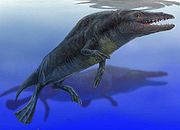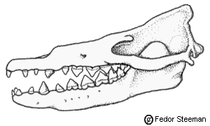
Rodhocetus
Encyclopedia
Rodhocetus is one of several extinct whale
genera that possess land mammal characteristics, thus demonstrating the evolutionary transition from land to sea.
 The first species to be discovered (Rhodocetus kasrani) exhibited such features as a large pelvis fused to the vertebrae, hind legs, and differentiated teeth. Of a recently discovered species (Rodhocetus balochistanensis), the ankle bones were recovered, further strengthening the already well-founded link to artiodactyl
The first species to be discovered (Rhodocetus kasrani) exhibited such features as a large pelvis fused to the vertebrae, hind legs, and differentiated teeth. Of a recently discovered species (Rodhocetus balochistanensis), the ankle bones were recovered, further strengthening the already well-founded link to artiodactyl
s, and weakening the link to mesonychid
s.
Rodhocetus balochistanensis is in fact believed to demonstrate a direct evolutionary link to artiodactyls (modern examples of which include hippopotamus
es, now believed to be the closest cousin species of the cetaceans). The structure of the ankle bones of this species, the trochlea
, is double-spooled. This trait is only known in artiodactyls, as all other mammalian orders have a single-spooled trochlea. This matches studies of the genetic relations between whales and other animals. Previous fossil-based hypotheses that whales were directly descended from mesonychid
s have been largely overturned.
The ear bones of Rodhocetus are already very whale-like, though the swimming style is very different. Rodhocetus is more obviously aquatic than earlier known species (e.g. Ambulocetus
) and had large, paddling hind feet to propel it through the water. It also had a strong tail which may have helped to act as a rudder.
Many suggest that Rodhocetus may have swum like a modern otter
, but through a principal components analysis
done in 2003, Philip Gingerich demonstrated that its limb proportions were closer to that of the Russian desman
.
 The first fossils of this species were found in Balochistan
The first fossils of this species were found in Balochistan
Province, Pakistan
in 2001 by Philip Gingerich. Dating from about 47 million years ago, they are one of a series of recent discoveries, including the pakicetid
s, which have thrown considerable light on the previously mysterious evolutionary origin of whales.
Whale
Whale is the common name for various marine mammals of the order Cetacea. The term whale sometimes refers to all cetaceans, but more often it excludes dolphins and porpoises, which belong to suborder Odontoceti . This suborder also includes the sperm whale, killer whale, pilot whale, and beluga...
genera that possess land mammal characteristics, thus demonstrating the evolutionary transition from land to sea.
Description

Even-toed ungulate
The even-toed ungulates are ungulates whose weight is borne about equally by the third and fourth toes, rather than mostly or entirely by the third as in odd-toed ungulates such as horses....
s, and weakening the link to mesonychid
Mesonychid
Mesonychia are an extinct order of medium to large-sized carnivorous mammals that were closely related to artiodactyls and to cetaceans...
s.
Rodhocetus balochistanensis is in fact believed to demonstrate a direct evolutionary link to artiodactyls (modern examples of which include hippopotamus
Hippopotamus
The hippopotamus , or hippo, from the ancient Greek for "river horse" , is a large, mostly herbivorous mammal in sub-Saharan Africa, and one of only two extant species in the family Hippopotamidae After the elephant and rhinoceros, the hippopotamus is the third largest land mammal and the heaviest...
es, now believed to be the closest cousin species of the cetaceans). The structure of the ankle bones of this species, the trochlea
Trochlea
Trochlea is a term in anatomy. It refers to a grooved structure reminiscent of a pulley's wheel.Most commonly, trochleae bear the articular surface of saddle and other joints:* Trochlea of humerus* Trochlear process of the Calcaneus...
, is double-spooled. This trait is only known in artiodactyls, as all other mammalian orders have a single-spooled trochlea. This matches studies of the genetic relations between whales and other animals. Previous fossil-based hypotheses that whales were directly descended from mesonychid
Mesonychid
Mesonychia are an extinct order of medium to large-sized carnivorous mammals that were closely related to artiodactyls and to cetaceans...
s have been largely overturned.
The ear bones of Rodhocetus are already very whale-like, though the swimming style is very different. Rodhocetus is more obviously aquatic than earlier known species (e.g. Ambulocetus
Ambulocetus
Ambulocetus was an early cetacean that could walk as well as swim. It lived during early Eocene some 50-49 million years ago. It is a transitional fossil that shows how whales evolved from land-living mammals. The Ambulocetus fossils were found in Pakistan by anthropologist Johannes Thewissen...
) and had large, paddling hind feet to propel it through the water. It also had a strong tail which may have helped to act as a rudder.
Many suggest that Rodhocetus may have swum like a modern otter
Otter
The Otters are twelve species of semi-aquatic mammals which feed on fish and shellfish, and also other invertebrates, amphibians, birds and small mammals....
, but through a principal components analysis
Principal components analysis
Principal component analysis is a mathematical procedure that uses an orthogonal transformation to convert a set of observations of possibly correlated variables into a set of values of uncorrelated variables called principal components. The number of principal components is less than or equal to...
done in 2003, Philip Gingerich demonstrated that its limb proportions were closer to that of the Russian desman
Russian Desman
The Russian Desman is a small semi-aquatic mammal that inhabits the Volga, Don and Ural River basins in Russia, Ukraine and Kazakhstan. It constructs burrows into the banks of ponds and slow-moving streams, but prefers small, overgrown ponds with abundance of insects, crayfish and amphibians...
.
Fossils

Balochistan (Pakistan)
Balochistan is one of the four provinces or federating units of Pakistan. With an area of 134,051 mi2 or , it is the largest province of Pakistan, constituting approximately 44% of the total land mass of Pakistan. According to the 1998 population census, Balochistan had a population of...
Province, Pakistan
Pakistan
Pakistan , officially the Islamic Republic of Pakistan is a sovereign state in South Asia. It has a coastline along the Arabian Sea and the Gulf of Oman in the south and is bordered by Afghanistan and Iran in the west, India in the east and China in the far northeast. In the north, Tajikistan...
in 2001 by Philip Gingerich. Dating from about 47 million years ago, they are one of a series of recent discoveries, including the pakicetid
Pakicetid
Pakicetids or Pakicetidae are a carnivorous mammal family of the suborder Archaeoceti which lived during the Early Eocene to Middle Eocene in Pakistan and existed for approximately ....
s, which have thrown considerable light on the previously mysterious evolutionary origin of whales.

